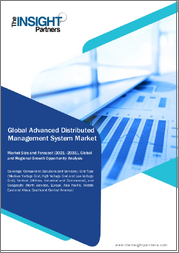
|
시장보고서
상품코드
1762039
세계의 첨단 배전 관리 시스템 시장 조사 보고서 : 산업 분석, 규모, 점유율, 성장, 동향, 예측(2025-2033년)Global Advanced Distribution Management System Market Research Report- Industry Analysis, Size, Share, Growth, Trends and Forecast 2025 to 2033 |
||||||
첨단 배전 관리 시스템 세계 시장 규모는 2024년 42억 9,000만 달러에서 2033년에는 233억 6,000만 달러로 성장하여 2026-2033년 예측 기간 동안 20.73%의 견조한 연평균 성장률(CAGR)을 나타낼 것으로 예측됩니다.
첨단 배전 관리 시스템(ADMS) 시장은 유틸리티 및 에너지 공급업체들이 배전망의 효율성과 신뢰성을 향상시키려는 노력으로 인해 크게 성장하고 있습니다. 에너지 시스템의 복잡성과 재생에너지의 통합에 따라 배전 업무를 최적화할 수 있는 고급 관리 솔루션에 대한 필요성이 가장 크게 대두되고 있으며, ADMS 솔루션을 통해 유틸리티 기업은 배전망을 실시간으로 모니터링, 제어 및 분석하여 업무 효율을 높이고 다운타임을 줄일 수 있습니다. 업무 효율성을 높이고 다운타임을 줄일 수 있습니다. 신뢰성 있고 탄력적인 에너지 시스템에 대한 수요가 증가함에 따라 ADMS 시장은 크게 확대될 것으로 예상되며, 인프라를 현대화하려는 유틸리티 기업들의 투자를 유치할 것으로 예상됩니다.
또한, 지속가능성과 규제 준수에 대한 중요성이 높아지면서 ADMS 시장이 더욱 활성화되고 있습니다. 각국 정부가 에너지 효율을 높이고 탄소 배출량을 줄이기 위해 더욱 엄격한 규제를 시행함에 따라, 유틸리티 기업들은 운영을 최적화하고 규제 요건을 충족하기 위해 첨단 관리 시스템을 채택하는 경향이 증가하고 있습니다. 스마트 그리드 기술과 데이터 분석이 ADMS 솔루션에 통합되면 그 기능이 강화되어 유틸리티 기업이 데이터 기반 의사결정을 내리고 전체 시스템 성능을 향상시킬 수 있습니다.
전기자동차(EV)와 분산형 에너지 자원(DER)의 증가는 ADMS 시장에 새로운 기회를 창출하고 있으며, EV의 보급이 증가함에 따라 전력회사들은 배전망이 충전 인프라 수요 증가에 대응할 수 있도록 해야 합니다. 솔루션은 운영 역량을 강화하고자 하는 유틸리티 사업자에게 필수적인 요소입니다. 첨단 배전 관리 시스템 시장은 기술 발전, 지속가능성에 대한 노력, 효율적인 에너지 관리 솔루션에 대한 수요 증가로 인해 성장할 수 있는 좋은 위치에 있습니다.
당사의 보고서는 고객에게 다양한 산업과 시장에 대한 포괄적이고 실용적인 인사이트를 제공할 수 있도록 세심하게 작성되었습니다. 각 보고서는 시장 상황을 완전히 이해하기 위해 몇 가지 중요한 요소를 포함하고 있습니다.
시장 개요 : 정의, 분류, 산업 현황 등 시장에 대한 자세한 소개.
시장 역학 : 시장 성장에 영향을 미치는 주요 촉진요인, 억제요인, 기회 및 과제를 자세히 분석합니다. 이 섹션에서는 기술 발전, 규제 변화, 새로운 트렌드 등의 요인을 검토합니다.
세분화 분석 : 제품 유형, 용도, 최종사용자, 지역 등의 기준에 따라 시장을 명확한 부문으로 분류합니다. 이 분석을 통해 각 부문의 성과와 잠재력을 파악할 수 있습니다.
경쟁 상황 : 시장 점유율, 제품 포트폴리오, 전략적 이니셔티브, 재무실적 등 주요 시장 진입기업에 대한 종합적인 평가. 주요 기업들이 채택하고 있는 경쟁 역학 및 주요 전략에 대한 인사이트이 포함되어 있습니다.
시장 예측 : 과거 데이터와 현재 시장 상황을 바탕으로 일정 기간 동안 시장 규모와 성장 추세를 예측합니다. 여기에는 정량적 분석과 향후 시장 궤적을 보여주는 그래프 표시가 포함됩니다.
지역 분석 : 지역별 시장 성과를 평가하고 주요 시장 및 지역 동향을 파악할 수 있습니다. 지역 시장 역학 및 비즈니스 기회를 이해하는 데 도움이 됩니다.
새로운 트렌드와 기회 : 현재 시장 동향과 새로운 시장 동향, 기술 혁신, 잠재적 투자 대상 부문을 식별합니다. 향후 개발 및 성장 전망에 대한 인사이트를 제공합니다.
목차
제1장 서문
제2장 주요 요약
- 시장 하이라이트
- 세계 시장 현황
제3장 첨단 배전 관리 시스템 산업 분석
- 소개 : 시장 역학
- 시장 성장 촉진요인
- 시장 성장 억제요인
- 시장 기회
- 산업 동향
- Porter's Five Forces 분석
- 시장 매력 분석
제4장 밸류체인 분석
- 밸류체인 분석
- 원료 분석
- 원료 리스트
- 원료 제조업체 리스트
- 주요 원료 가격 동향
- 잠재적 바이어 리스트
- 마케팅 채널
- 직접 마케팅
- 간접 마케팅
- 마케팅 채널 발전 동향
제5장 첨단 배전 관리 시스템 세계 시장 분석 : 솔루션별
- 솔루션별 개요
- 솔루션별 과거·예측 데이터 분석
- 에너지 관리 시스템
- 정전 관리 시스템
- 지리정보시스템
- 고객 정보 시스템
- 기타
제6장 첨단 배전 관리 시스템 세계 시장 분석 : 서비스별
- 서비스별 개요
- 서비스별 과거·예측 데이터 분석
- 매니지드 서비스
- 전문 서비스
제7장 첨단 배전 관리 시스템 세계 시장 분석 : 전개 방식별
- 전개 방식별 개요
- 전개 방식별 과거·예측 데이터 분석
- 클라우드
- 온프레미스
제8장 첨단 배전 관리 시스템 세계 시장 분석 : 최종 용도별
- 최종 용도별 개요
- 최종 용도별 과거·예측 데이터 분석
- 제조업
- 정부기관
- IT·통신
- 자동차·운송
- 기타
제9장 첨단 배전 관리 시스템 세계 시장 분석 : 지역별
- 지역별 전망
- 소개
- 북미의 매출 분석
- 개요, 실적과 예측
- 북미 : 부문별
- 북미 : 국가별
- 미국
- 캐나다
- 멕시코
- 유럽의 매출 분석
- 개요, 실적과 예측
- 유럽 : 부문별
- 유럽 : 국가별
- 영국
- 프랑스
- 독일
- 이탈리아
- 러시아
- 기타 유럽
- 아시아태평양의 매출 분석
- 개요, 실적과 예측
- 아시아태평양 : 부문별
- 아시아태평양 : 국가별
- 중국
- 인도
- 일본
- 한국
- 호주
- 동남아시아
- 기타 아시아태평양
- 라틴아메리카의 매출 분석
- 개요, 실적과 예측
- 라틴아메리카 : 부문별
- 라틴아메리카 : 국가별
- 브라질
- 아르헨티나
- 페루
- 칠레
- 기타 라틴아메리카
- 중동 및 아프리카의 매출 분석
- 개요, 실적과 예측
- 중동 및 아프리카 : 부문별
- 중동 및 아프리카 : 국가별
- 사우디아라비아
- 아랍에미리트
- 이스라엘
- 남아프리카공화국
- 기타 중동 및 아프리카
제10장 첨단 배전 관리 시스템 기업 경쟁 구도
- 첨단 배전 관리 시스템 시장 경쟁
- 제휴·협력·계약
- 인수합병
- 신제품 발매
- 기타 개발
제11장 기업 개요
- 상위 기업의 시장 점유율 분석
- 시장 집중도
- AutoGrid
- Depsys SA
- Eaton Corporation
- Electrical Transient Analyzer Program
- Elipse Software
- General Electric
- Hitachi Ltd.
- IBM Corporation
- Itron
- Landis+GYR
- Minsait ACS
- Opus One Solutions
- PXiSE Energy Solutions
- Schneider Electric
- Siemens AG
Global Advanced Distribution Management System Market size is anticipated to grow from USD 4.29 Billion in 2024 to USD 23.36 Billion by 2033, showcasing a robust Compound Annual Growth Rate (CAGR) of 20.73% during the forecast period of 2026 to 2033.
The advanced distribution management system (ADMS) market is poised for significant growth as utilities and energy providers seek to enhance the efficiency and reliability of their distribution networks. With the increasing complexity of energy systems and the integration of renewable energy sources, the need for advanced management solutions that can optimize distribution operations is becoming paramount. ADMS solutions enable utilities to monitor, control, and analyze their distribution networks in real-time, improving operational efficiency and reducing downtime. As the demand for reliable and resilient energy systems grows, the ADMS market is expected to expand significantly, attracting investments from utilities looking to modernize their infrastructure.
Moreover, the growing emphasis on sustainability and regulatory compliance is further propelling the ADMS market. As governments implement stricter regulations to promote energy efficiency and reduce carbon emissions, utilities are increasingly adopting advanced management systems to optimize their operations and meet regulatory requirements. The integration of smart grid technologies and data analytics into ADMS solutions will enhance their capabilities, allowing utilities to make data-driven decisions and improve overall system performance.
Additionally, the rise of electric vehicles (EVs) and distributed energy resources (DERs) is creating new opportunities within the ADMS market. As the adoption of EVs increases, utilities must adapt their distribution networks to accommodate the growing demand for charging infrastructure. ADMS solutions that can effectively manage the integration of EVs and DERs will be essential for utilities seeking to enhance their operational capabilities. The advanced distribution management system market is well-positioned for growth, driven by technological advancements, sustainability initiatives, and the increasing need for efficient energy management solutions.
Our reports are meticulously crafted to provide clients with comprehensive and actionable insights into various industries and markets. Each report encompasses several critical components to ensure a thorough understanding of the market landscape:
Market Overview: A detailed introduction to the market, including definitions, classifications, and an overview of the industry's current state.
Market Dynamics: In-depth analysis of key drivers, restraints, opportunities, and challenges influencing market growth. This section examines factors such as technological advancements, regulatory changes, and emerging trends.
Segmentation Analysis: Breakdown of the market into distinct segments based on criteria like product type, application, end-user, and geography. This analysis highlights the performance and potential of each segment.
Competitive Landscape: Comprehensive assessment of major market players, including their market share, product portfolio, strategic initiatives, and financial performance. This section provides insights into the competitive dynamics and key strategies adopted by leading companies.
Market Forecast: Projections of market size and growth trends over a specified period, based on historical data and current market conditions. This includes quantitative analyses and graphical representations to illustrate future market trajectories.
Regional Analysis: Evaluation of market performance across different geographical regions, identifying key markets and regional trends. This helps in understanding regional market dynamics and opportunities.
Emerging Trends and Opportunities: Identification of current and emerging market trends, technological innovations, and potential areas for investment. This section offers insights into future market developments and growth prospects.
SEGMENTATION COVERED IN THE REPORT
By Solution
- Energy Management System
- Outage Management System
- Geographic Information System
- Customer Information System
- Others
By Services
- Managed Services
- Professional Services
By Deployment Type
- Cloud
- On-premises
By End-Use
- Manufacturing
- Government
- IT & Telecom
- Automotive & Transportation
- Others
- COMPANIES PROFILED
- AutoGrid
- depsys SA
- Eaton Corporation
- Electrical Transient Analyzer Program
- Elipse Software
- General Electric
- Hitachi Ltd.
- IBM Corporation
- Itron
- Landis+GYR
- Minsait ACS
- Opus One Solutions
- PXiSE Energy Solutions
- Schneider Electric
- Siemens AG.
- The above list can be customized.
TABLE OF CONTENTS
1. PREFACE
- 1.1. Report Description
- 1.1.1 Objective
- 1.1.2 Target Audience
- 1.1.3 Unique Selling Proposition (USP) & offerings
- 1.2. Research Scope
- 1.3. Research Methodology
- 1.3.1 Market Research Process
- 1.3.2 Market Research Methodology
2. EXECUTIVE SUMMARY
- 2.1. Highlights of Market
- 2.2. Global Market Snapshot
3. ADVANCED DISTRIBUTION MANAGEMENT SYSTEM INDUSTRY ANALYSIS
- 3.1. Introduction - Market Dynamics
- 3.2. Market Drivers
- 3.3. Market Restraints
- 3.4. Opportunities
- 3.5. Industry Trends
- 3.6. Porter's Five Force Analysis
- 3.7. Market Attractiveness Analysis
- 3.7.1 Market Attractiveness Analysis By Solution
- 3.7.2 Market Attractiveness Analysis By Services
- 3.7.3 Market Attractiveness Analysis By Deployment Type
- 3.7.4 Market Attractiveness Analysis By End-Use
- 3.7.5 Market Attractiveness Analysis By Regions
4. VALUE CHAIN ANALYSIS
- 4.1. Value Chain Analysis
- 4.2. Raw Material Analysis
- 4.2.1 List of Raw Materials
- 4.2.2 Raw Material Manufactures List
- 4.2.3 Price Trend of Key Raw Materials
- 4.3. List of Potential Buyers
- 4.4. Marketing Channel
- 4.4.1 Direct Marketing
- 4.4.2 Indirect Marketing
- 4.4.3 Marketing Channel Development Trend
5. GLOBAL ADVANCED DISTRIBUTION MANAGEMENT SYSTEM MARKET ANALYSIS BY SOLUTION
- 5.1. Overview By Solution
- 5.2. Historical and Forecast Data Analysis By Solution
- 5.3. Energy Management System Historic and Forecast Sales By Regions
- 5.4. Outage Management System Historic and Forecast Sales By Regions
- 5.5. Geographic Information System Historic and Forecast Sales By Regions
- 5.6. Customer Information System Historic and Forecast Sales By Regions
- 5.7. Others Historic and Forecast Sales By Regions
6. GLOBAL ADVANCED DISTRIBUTION MANAGEMENT SYSTEM MARKET ANALYSIS BY SERVICES
- 6.1. Overview By Services
- 6.2. Historical and Forecast Data Analysis By Services
- 6.3. Managed Services Historic and Forecast Sales By Regions
- 6.4. Professional Services Historic and Forecast Sales By Regions
7. GLOBAL ADVANCED DISTRIBUTION MANAGEMENT SYSTEM MARKET ANALYSIS BY DEPLOYMENT TYPE
- 7.1. Overview By Deployment Type
- 7.2. Historical and Forecast Data Analysis By Deployment Type
- 7.3. Cloud Historic and Forecast Sales By Regions
- 7.4. On-premises Historic and Forecast Sales By Regions
8. GLOBAL ADVANCED DISTRIBUTION MANAGEMENT SYSTEM MARKET ANALYSIS BY END-USE
- 8.1. Overview By End-Use
- 8.2. Historical and Forecast Data Analysis By End-Use
- 8.3. Manufacturing Historic and Forecast Sales By Regions
- 8.4. Government Historic and Forecast Sales By Regions
- 8.5. IT & Telecom Historic and Forecast Sales By Regions
- 8.6. Automotive & Transportation Historic and Forecast Sales By Regions
- 8.7. Others Historic and Forecast Sales By Regions
9. GLOBAL ADVANCED DISTRIBUTION MANAGEMENT SYSTEM MARKET ANALYSIS BY GEOGRAPHY
- 9.1. Regional Outlook
- 9.2. Introduction
- 9.3. North America Sales Analysis
- 9.3.1 Overview, Historic and Forecast Data Sales Analysis
- 9.3.2 North America By Segment Sales Analysis
- 9.3.3 North America By Country Sales Analysis
- 9.3.4 United States Sales Analysis
- 9.3.5 Canada Sales Analysis
- 9.3.6 Mexico Sales Analysis
- 9.4. Europe Sales Analysis
- 9.4.1 Overview, Historic and Forecast Data Sales Analysis
- 9.4.2 Europe By Segment Sales Analysis
- 9.4.3 Europe By Country Sales Analysis
- 9.4.4 United Kingdom Sales Analysis
- 9.4.5 France Sales Analysis
- 9.4.6 Germany Sales Analysis
- 9.4.7 Italy Sales Analysis
- 9.4.8 Russia Sales Analysis
- 9.4.9 Rest Of Europe Sales Analysis
- 9.5. Asia Pacific Sales Analysis
- 9.5.1 Overview, Historic and Forecast Data Sales Analysis
- 9.5.2 Asia Pacific By Segment Sales Analysis
- 9.5.3 Asia Pacific By Country Sales Analysis
- 9.5.4 China Sales Analysis
- 9.5.5 India Sales Analysis
- 9.5.6 Japan Sales Analysis
- 9.5.7 South Korea Sales Analysis
- 9.5.8 Australia Sales Analysis
- 9.5.9 South East Asia Sales Analysis
- 9.5.10 Rest Of Asia Pacific Sales Analysis
- 9.6. Latin America Sales Analysis
- 9.6.1 Overview, Historic and Forecast Data Sales Analysis
- 9.6.2 Latin America By Segment Sales Analysis
- 9.6.3 Latin America By Country Sales Analysis
- 9.6.4 Brazil Sales Analysis
- 9.6.5 Argentina Sales Analysis
- 9.6.6 Peru Sales Analysis
- 9.6.7 Chile Sales Analysis
- 9.6.8 Rest of Latin America Sales Analysis
- 9.7. Middle East & Africa Sales Analysis
- 9.7.1 Overview, Historic and Forecast Data Sales Analysis
- 9.7.2 Middle East & Africa By Segment Sales Analysis
- 9.7.3 Middle East & Africa By Country Sales Analysis
- 9.7.4 Saudi Arabia Sales Analysis
- 9.7.5 UAE Sales Analysis
- 9.7.6 Israel Sales Analysis
- 9.7.7 South Africa Sales Analysis
- 9.7.8 Rest Of Middle East And Africa Sales Analysis
10. COMPETITIVE LANDSCAPE OF THE ADVANCED DISTRIBUTION MANAGEMENT SYSTEM COMPANIES
- 10.1. Advanced Distribution Management System Market Competition
- 10.2. Partnership/Collaboration/Agreement
- 10.3. Merger And Acquisitions
- 10.4. New Product Launch
- 10.5. Other Developments
11. COMPANY PROFILES OF ADVANCED DISTRIBUTION MANAGEMENT SYSTEM INDUSTRY
- 11.1. Top Companies Market Share Analysis
- 11.2. Market Concentration Rate
- 11.3. AutoGrid
- 11.3.1 Company Overview
- 11.3.2 Company Revenue
- 11.3.3 Products
- 11.3.4 Recent Developments
- 11.4. Depsys SA
- 11.4.1 Company Overview
- 11.4.2 Company Revenue
- 11.4.3 Products
- 11.4.4 Recent Developments
- 11.5. Eaton Corporation
- 11.5.1 Company Overview
- 11.5.2 Company Revenue
- 11.5.3 Products
- 11.5.4 Recent Developments
- 11.6. Electrical Transient Analyzer Program
- 11.6.1 Company Overview
- 11.6.2 Company Revenue
- 11.6.3 Products
- 11.6.4 Recent Developments
- 11.7. Elipse Software
- 11.7.1 Company Overview
- 11.7.2 Company Revenue
- 11.7.3 Products
- 11.7.4 Recent Developments
- 11.8. General Electric
- 11.8.1 Company Overview
- 11.8.2 Company Revenue
- 11.8.3 Products
- 11.8.4 Recent Developments
- 11.9. Hitachi Ltd.
- 11.9.1 Company Overview
- 11.9.2 Company Revenue
- 11.9.3 Products
- 11.9.4 Recent Developments
- 11.10. IBM Corporation
- 11.10.1 Company Overview
- 11.10.2 Company Revenue
- 11.10.3 Products
- 11.10.4 Recent Developments
- 11.11. Itron
- 11.11.1 Company Overview
- 11.11.2 Company Revenue
- 11.11.3 Products
- 11.11.4 Recent Developments
- 11.12. Landis+GYR
- 11.12.1 Company Overview
- 11.12.2 Company Revenue
- 11.12.3 Products
- 11.12.4 Recent Developments
- 11.13. Minsait ACS
- 11.13.1 Company Overview
- 11.13.2 Company Revenue
- 11.13.3 Products
- 11.13.4 Recent Developments
- 11.14. Opus One Solutions
- 11.14.1 Company Overview
- 11.14.2 Company Revenue
- 11.14.3 Products
- 11.14.4 Recent Developments
- 11.15. PXiSE Energy Solutions
- 11.15.1 Company Overview
- 11.15.2 Company Revenue
- 11.15.3 Products
- 11.15.4 Recent Developments
- 11.16. Schneider Electric
- 11.16.1 Company Overview
- 11.16.2 Company Revenue
- 11.16.3 Products
- 11.16.4 Recent Developments
- 11.17. Siemens AG
- 11.17.1 Company Overview
- 11.17.2 Company Revenue
- 11.17.3 Products
- 11.17.4 Recent Developments



















